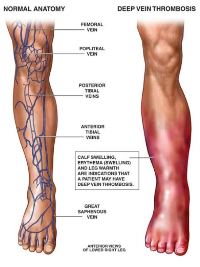Driver Lifestyles
Occupational Health Hazard: Deep Vein Thrombosis
What do people who fly long distances, elderly people and truck drivers have in common, the possibility of developing deep vein thrombosis (DVT). All may sit for long periods of time causing lack of circulation in the lower body leading to the development of blood clots in the lower extremities. Veins in the calf and thigh are most usually affected by DVT though the arm can also develop it. There are other causes of DVT, hormone therapy, oral contraceptives, surgery, long-term illnesses and trauma causing damage to veins.
Other risk
factors are, (from Wikipedia)
Cancers, especially of the bone, ovary, brain, pancreas, and lymphomas
Inactivity and immobilization, as with orthopedic casts
Pregnancy and the postpartum period
Antiphospholipid syndrome (such as lupus)
Minor leg injury and lower limb amputation
Central venous catheters
Inflammatory diseases/some autoimmune diseases
Nephrotic syndrome
Obesity
Infection
HIV
Polycythemia vera
Chemotherapy
Symptoms of DVT are swelling, heat in the area affected, discoloration of skin, possible open sores in severe cases, infections and pain. There may also be tingling in the foot or toes as the swelling compresses nerves. DVT is commonly found by using ultra sound though MRI and CT scans are also sometimes used.
When blood flow is cut off or slowed, clots may form, further slowing the blood flow if not stopping it completely. After the clot forms, it may break loose from the inner lining of the vein and travel. If it gets to a person’s lungs or brain, it can cause death. Severe DVT left untreated can also cause such damage that amputation of the affected limb has to be done. Once DVT is found, anticoagulants (blood thinners) may be prescribed. In those without pain, bed rest may be in order, those with the worst symptoms may be hospitalized.
Truck drivers are very apt to develop DVT, for them, it is an occupational health hazard, due to leading a very sedentary lifestyle and sitting for hours without any real movement which cuts off blood flow. DVT found in truckers, is in the lower leg unless caused by surgery or injury. Some of the other things affecting truckers developing DVT is wearing too tight jeans, socks, boots or not having the front of the seat positioned properly for their leg length; all of these can cut off the flow of blood.
One of the easiest things to do to prevent DVT is to get out and walk at least every couple of hours to get the blood circulating; this does not have to take a long time, a trip around the rig a time or two will at least help. A trucker might also rotate their ankles or wiggle their toes while driving. Isometric exercises where one clenches the calf and thigh muscles often can also increase circulation. Graduated compression stockings are also useful to help force the blood back towards the heart. Something as simple as putting one’s feet higher than their head while resting can help reduce the possibility of DVT. Dehydration can also help DVT to develop; drinking plenty of water can be effective.
DVT is a very real hazard to truckers. It can develop and might not be really noticed until clots form and the pain becomes real. DVT is nothing to mess with, if there is swelling in the leg that does not go down by morning or any of the other symptoms, a trucker needs to seek immediate medical care. The best thing though is preventing DVT from getting started in the first place though a little exercise throughout the day.
